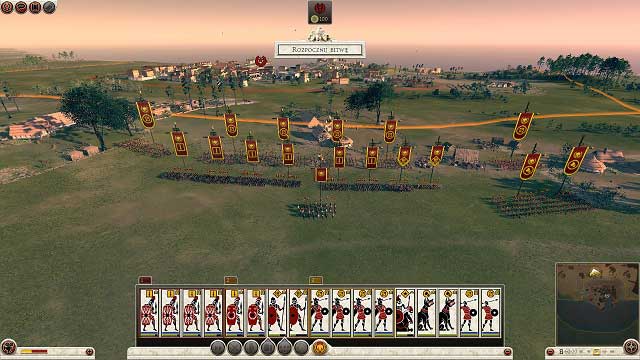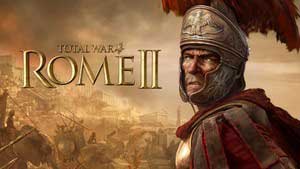Battlefield | Battle TW: Rome II Guide
Last update: 11 May 2016
Deploying forces
When it comes to the battle as a result of movement of troops on the strategic map, you'll be transferred to the battlefield, which is a part of the main map. Regardless of the type of the fight, controlling the units remains unchanged in most of cases. If it is your forces which attacked enemy, you'll get a possibility to choose a convenient weather conditions. Rain or snow makes the troops more fatigued and you won't be able to use fire arrows. Fog limits the range of sights, giving you less time to react to enemy movements and decreasing the effectiveness of projectile troops. So if it is you who has an edge in projectile units, it would be best to fight under the clear sky - otherwise you should use worse weather conditions.

Regardless of the weather, the next step is to deploy troops. Despite the fact, that it takes few minutes until the first fight takes place, you should predict enemy settings right now and properly form your ranks. Usually you set your units in lines: spearmen, followed by infantry, secured by cavalry on sides. On back of your army you should have war machines, capable to attack enemy from a greater distance. Your general should be located behind infantry, so he won't be exposed to the direct attack. Of course, there are more possibilities to deploy your troops - later on I'll try to present several different formations and maneuvers. In case when you defend a fortified position, you'll be able to deploy barricades, spike traps or stakes.

Terrain
The terrain where the fight takes place is crucial both during the troops' deployment and planning the coming battle. Dense forests are perfect place to hide flanking cavalry or infantry - at the same time they cover your soldiers against enemy projectile units. When deploying your troops, as well as moving them over the battlefield, you should always watch out not to put them into ambush - it would be the best to send some light cavalry or skirmishers as scouts first.

Uphill are also important points on the battlefield. Since your troops' line of sight is straight, deploying them behind the hill will make them invisible for the enemy. Hilltops are also excellent defensive positions. Projectile units placed there will be able to attack enemy more effectively and infantry and cavalry will have better position to charge on enemy, when his troops are ascending the hill.
The most dangerous places on the map are so called "cirques" - locations surrounded by hills or forests on all sides. The unit located in its center has a limited line of sight and maneuver and the enemy can attack from any direction and quickly kill your troops.
The last most common type of terrain is buildings and fortifications. During the siege of the settlement you'll often come across narrow streets delimited by houses walls - there are excellent places to deploy spearmen or pikemen phalanx. Heavy infantry will be both safe from the enemy fire and it will be impossible to flank it. On the other hand, if the enemy manages to get on your backs, the unit can be considered lost, because it has no way to escape.

In settlements you'll come across bigger buildings from time to time, where can you deploy your projectile units - I recommend using them when it is possible or at least block an access to them for your enemy. Barbarians' settlements often have an uphill in the center, making an organized attack much more difficult and making it easier to defend. In addition they have palisades which reduce possible attack directions.

In case of siege the province capital you'll come across thick walls surrounding the city. This time you'll have to use war machines in order to make a breakthrough or damage the walls, so your projectile units can shoot enemy. In case when you have no war machines, infantry with fire projectiles can make the gates open after intense bombardment, but such attack is risky, because enemy projectile units will certainly try to stop you.

In order to make sieges easier, I recommend equipping army with appropriate equipment (ballista, onager) or create it on sire - by spending one or two turns for creating rams and ladders you could significantly reduce your casualties.
Tactics
Functions of each unit on the battlefield depend largely on the terrain and your and enemy army line-up. Since fights in Total War: Rome II resemble a game of rock-paper-scissors, it is important to choose a proper unit for a specific task.
The battle usually starts when two armies set in formations chosen by generals are placed against each other. First units which go to the battle are skirmishers - infantry or missile cavalry with javelins, bows or slingshots. Your task is to counter them in order to make place for maneuvering. To do this, use your own projectile units (make sure to focus their attack on one enemy unit until you completely destroy it) - best for this task are slingers and archers because of the long range. If you have light or medium cavalry or chariots, you can attempt to attack isolated skirmishers - you have only to watch out for enemy riders, who are willing to fight your riders in melee clashes until the arrival of infantry.
Once you're done with projectile units, you can use the rest of your troops' ammunition to depletion of enemy main forces. Slingers should aim for poorly armored infantry and cavalry while archers and javelinmen can attack heavy armored enemy units. The enemy under fire has now two choices: wait patiently until your missile attack is over or move to attack. Regardless of the choice, sooner or later you'll meet in melee fight.
At this point a lot depends on the line-up of your army and faction you command. Most often the most important task will be holding the center of the formation and breaking through on enemy flanks, which will allow you to surround the entire army. For that you need both heavy, well-armored infantry (legionaries, pikemen phalanx, elite hoplites or spearmen), which will take the charge of the enemy, as well as shock troops that can quickly move over the battlefield. In this case you can use light shock infantry (hillmen, sword masters), mobile heavy infantry (triarii), cavalry, chariots or even war elephants). Defeating side guards will allow you to turn back your troops and direct them to attack backs of troops fighting in the center. This attack almost always ends with enemy troops fleeing in panic - just finish them off so they won't return to the fight.
Such clashes look nice on the paper but in reality the battlefield is much more variable. A forest located in the flank can hide the elite enemy cavalry, which can easily break through your flanks. Basins will allow your opponent to shoot your troops without possibility to fight back. Fights in narrow city streets won't allow you to change the length of your ranks - the one, who has stronger infantry here, wins. There are countless possibilities and it depends on the general or rather on the player, whether he is able to adapt to changing conditions on the battlefield.
